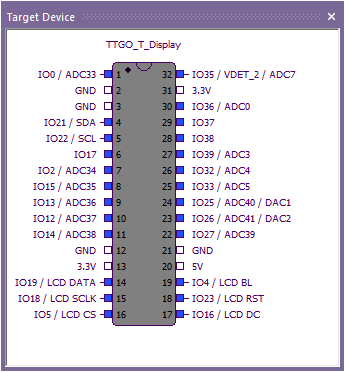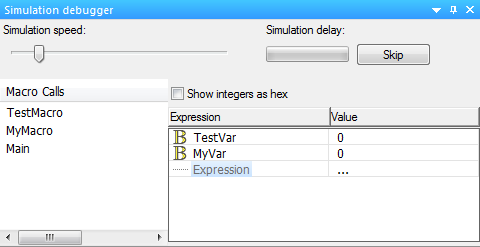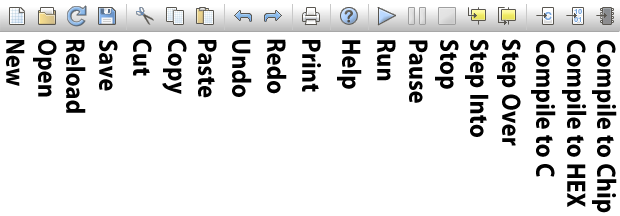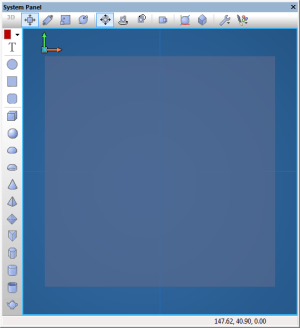Difference between revisions of "Ribbon Toolbar"
| Line 57: | Line 57: | ||
===[[Dashboard Panel|2D: Dashboard Panel]]=== | ===[[Dashboard Panel|2D: Dashboard Panel]]=== | ||
| − | The Dashboard Panel provides | + | |
| + | The Dashboard Panel provides a 2D window on which to load Flowcode components. It can be used for any component but is suited towards none 3D components such as buttons, switches, displays. | ||
===[[System Panel|3D System Panel]]=== | ===[[System Panel|3D System Panel]]=== | ||
| − | The | + | |
| + | The System Panel provides a 3D (real-world) framework on which to load Flowcode components to provide a 3D simulation. It can be used for most components however will not work with the new 2D only GUI simulation components. | ||
| + | |||
| + | |||
| + | ===[[Properties_Panel|Component Properties]]=== | ||
| + | |||
| + | The component properties window allows you to view and edit settings specific to the current selected component. The top of the window features a drop down list which lists all of the panel components included in the project. | ||
| + | ===[[Find_and_Replace]]=== | ||
| + | The find and replace window allows you to search the current macro or project for a keyword and provides means to replace the keyword and filter by icon type. | ||
| + | ===[[Change History|Change History]]=== | ||
| + | A text based history of recent changes in the program allowing you to jump forwards and backward through the change history. | ||
| Line 91: | Line 102: | ||
| − | + | ||
Revision as of 12:12, 26 October 2020
Contents
- 1 Introduction
- 2 Video instructions
- 3 Icons Toolbar
- 4 Components Toolbar
- 5 View Toolbar
- 5.1 Project Explorer
- 5.2 2D: Dashboard Panel
- 5.3 3D System Panel
- 5.4 Component Properties
- 5.5 Find_and_Replace
- 5.6 Change History
- 5.7 Chip View
- 5.8 Digital Pins
- 5.9 Analog Window
- 5.10 8) Icon Lists
- 5.11 9) Simulation Debugger
- 5.12 10) Main Toolbar
- 5.13 11) Status Bar
- 5.14 12) Zoom Level
- 5.15 4) Flowchart Window
Introduction
The Flowcode environment consists of a main work area in which the flowchart windows are displayed, several toolbars that allow icon and components to be added to the flowchart application, windows that allow the status of the microcontroller and attached components to be viewed and windows that display variables and macro calls when the flow chart is being simulated.
From the View menu you are able to customise Flowcode to hide and display panel windows such as the Dashboard Panel, System Panel, Properties Panel, Component Debugger and much more, you can also show / hide the Toolbars referenced as Toolboxes, e.g. the 'Main Toolbar', 'Components Toolbar' or rather Toolbox, as well as the 'Icons Toolbar' otherwise known as the 'Command Toolbox'
Video instructions
See the Accessing and Arranging Flowcode Panels video to learn how to organize the application to your preference and manage your work space effectively for optimal productivity and ease of access.
Watch the Toolbars and Buttons video to learn how to use each toolbar effectively as well as learning specific details and functions of each toolbar button.
Finally, view the Tabbed Flowcharts and Macros video to see how to control the interface when managing macros, from tabbed flowcharts and macros to viewing two macro flowcharts on one screen.
| FXa7LJsRvAs}} | 9c6FIZTfGmA}} | |
| {{#ev:youtube|c0d47BSkKS4}} | ||
Icons Toolbar
Drag and drop Flowchart and State Diagram icons from the Command Icons toolbar onto the main flowchart window to create your flowchart application.
The Icons tab of the Project explorer window also contains Flowchart and State Diagram icons.
Components Toolbar
This toolbar displays the component libraries that can be included in your program. Click on a component and it can be added onto either the Dashboard Panel or the System Panel and will be automatically connected to the microcontroller in the Chip view.
The properties of the component such as Pin connections, Configuration Parameters and other settings can be edited using the Properties window.
View Toolbar
The following elements can be switched on and off using the view toolbar section of the main ribbon.
Project Explorer
The project explorer allows you to easily manipulate the key constituents of your project. Left clicking on the arrow or right clicking on the various objects in the explorer will bring up a menu relevant to that object. The 'Macro' and 'Components' icons can be dragged into the main window to be placed as icons.
2D: Dashboard Panel
The Dashboard Panel provides a 2D window on which to load Flowcode components. It can be used for any component but is suited towards none 3D components such as buttons, switches, displays.
3D System Panel
The System Panel provides a 3D (real-world) framework on which to load Flowcode components to provide a 3D simulation. It can be used for most components however will not work with the new 2D only GUI simulation components.
Component Properties
The component properties window allows you to view and edit settings specific to the current selected component. The top of the window features a drop down list which lists all of the panel components included in the project.
Find_and_Replace
The find and replace window allows you to search the current macro or project for a keyword and provides means to replace the keyword and filter by icon type.
Change History
A text based history of recent changes in the program allowing you to jump forwards and backward through the change history.
Chip View
The pins of the selected target microcontroller is displayed in this window.
When the flowchart is being simulated, the state of the microcontroller I/O ports are shown on the microcontroller as red and grey for high and low outputs respectively.
Digital Pins
The digital pins window.
Analog Window
The analogue inputs window.
8) Icon Lists
This window shows a list of the icons that: have been bookmarked; are set as breakpoints; are search results or have shown to cause an error after compilation. Left clicking on the arrow or right clicking on the various objects in the icon list will bring up a menu relevant to that object.
9) Simulation Debugger
This window appears when simulating a flowchart, it shows the current macro being simulated as well as the values of any variables selected, the values of the variables are updated for every command simulated but does not update when running the simulation 'As fast as possible'.
When simulating a flowchart, the values of any variables used can be seen in this view. The values of the variables are updated for every command simulated but the view is not updated when the simulation is running at full speed.
10) Main Toolbar
Use this command to display and hide the Toolbar, which includes buttons for some of the most common commands in Flowcode, such as 'Open' (File > Open), 'Print' (File > Print) as well as Compiling the flowchart to Chip, HEX and C. You can even control simulation by running, pausing and stopping simulation using this toolbar as stepping into and over icons to simulate step by step.
11) Status Bar
Use this command to display and hide the Status Bar displayed at the bottom of the Flowcode window, which describes the action to be executed by the selected menu item or depressed toolbar button, and keyboard latch state. A check mark appears next to the menu item when the Status Bar is displayed.
12) Zoom Level
The currently selected Zoom level is displayed on the right side of the Status Bar. You can change the 'Zoom' using keyboard shortcuts such as F2 to 'Decrease' the zoom, F3 to 'Increase' the zoom and F4 to set the zoom at '75%' you can also select the options in the 'Zoom' sub-menu in the 'View' menu (View > Zoom > ), this menu also displays the 'Current zoom' level and allows you to change the zoom to 25%, 50%, 75% or 100% as well as the ability to 'Zoom to Fit' and 'Zoom to Fit Width'.
4) Flowchart Window
The icons that make up the flowchart are displayed in this window. In addition, the icons that make up a macro are shown in their own separate window. The Main flowchart window is always visible and the macro windows can be shown and hidden as needed.




